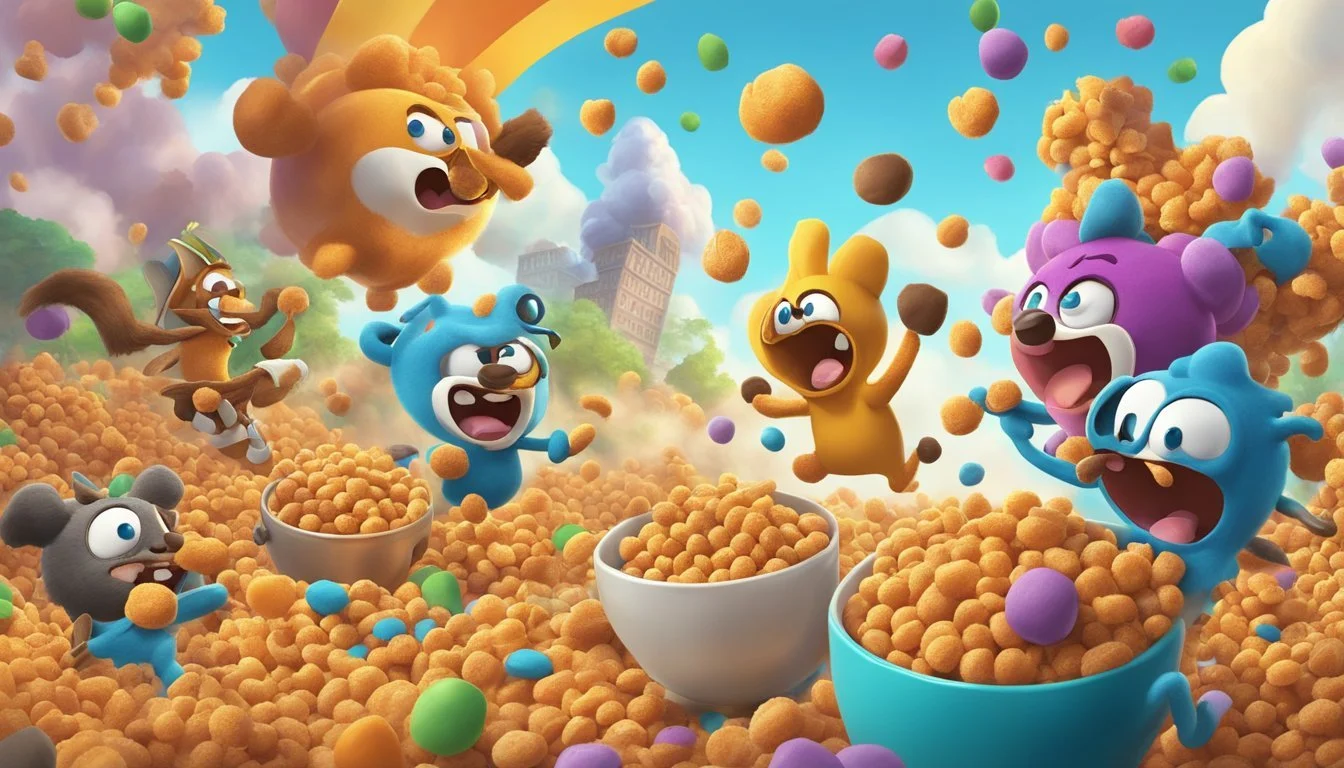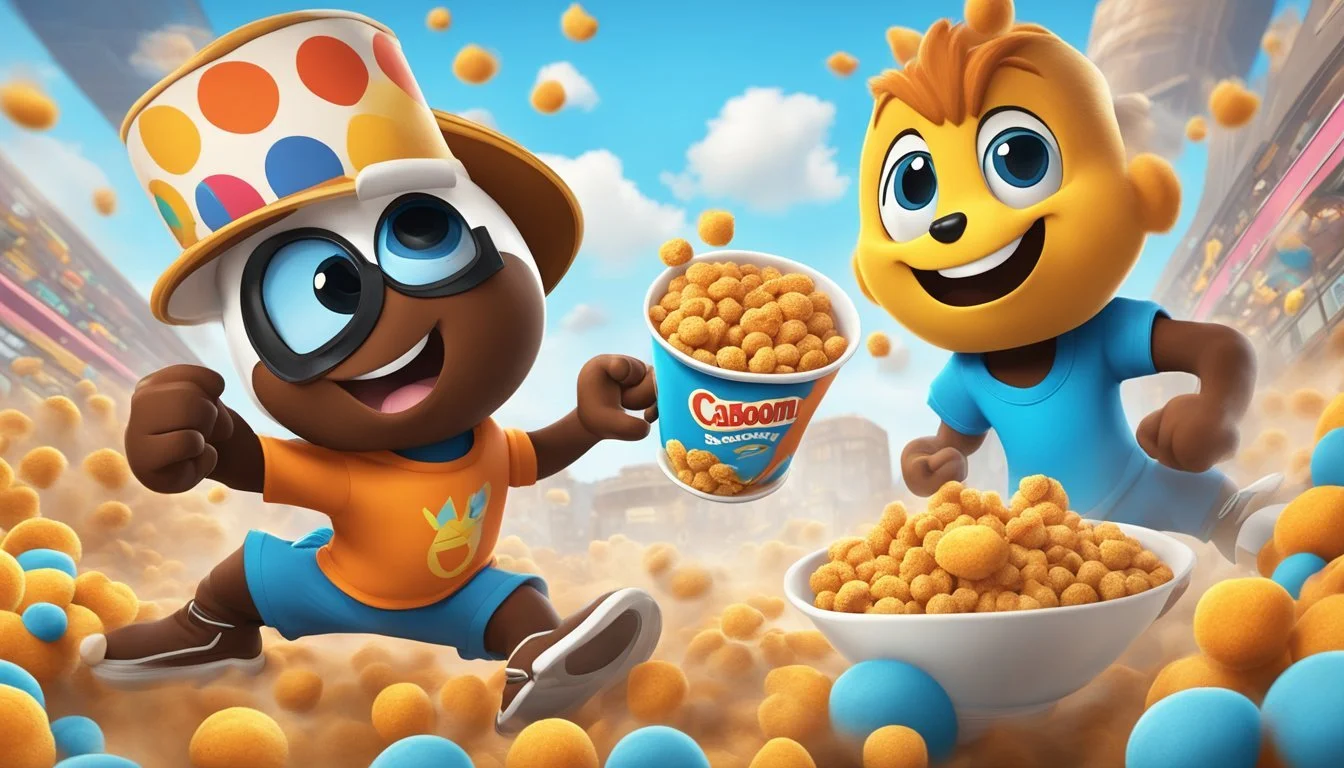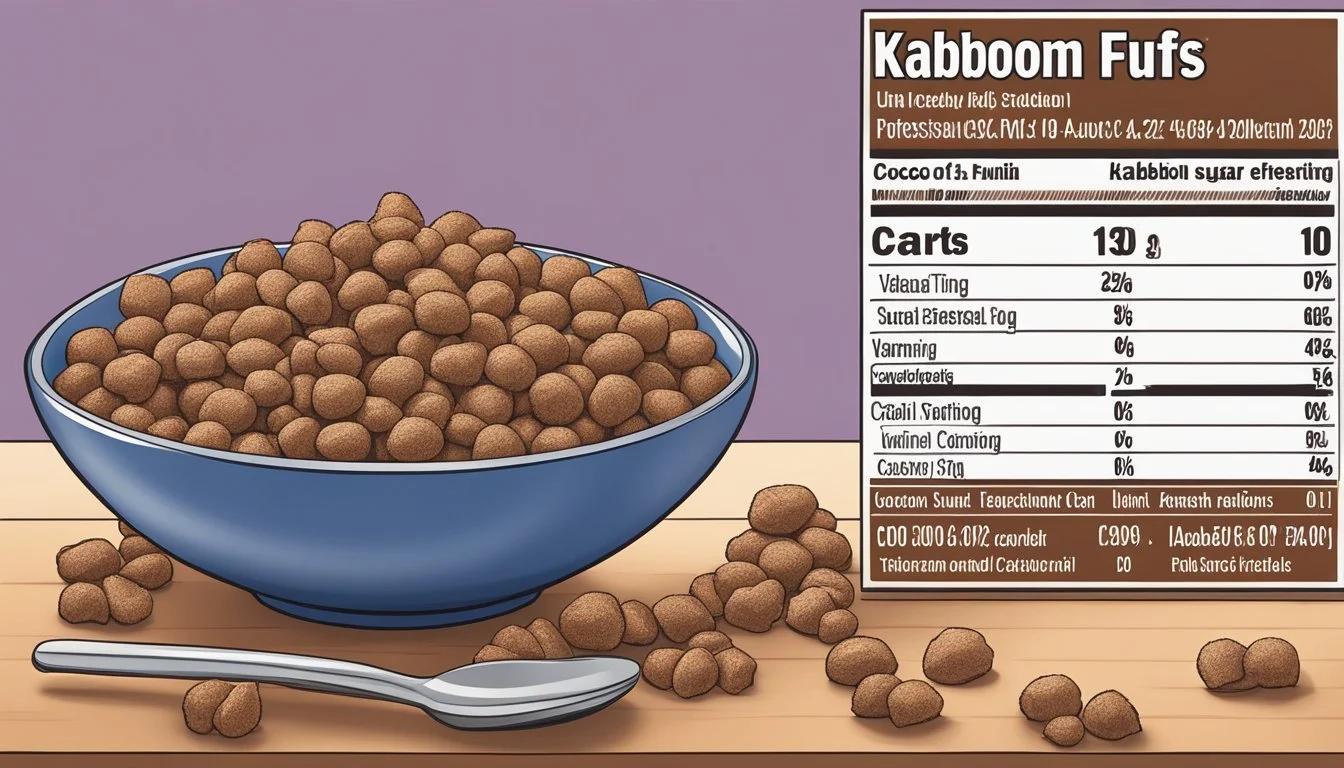Cocoa Puffs vs Kaboom
A Comprehensive Cereal Comparison
This Article is Part of Our Breakfast Cereal Guide with Details on Cocoa Puffs Nutrition and Kaboom Nutrition
When it comes to choosing a breakfast cereal, the debate between Cocoa Puffs and Kaboom often arises due to their distinct flavors and nutritional profiles. Cocoa Puffs, known for their rich chocolate taste and crunchy texture, have long been a favorite among chocolate cereal enthusiasts. Kaboom, on the other hand, offers a fruity flavor that stands out for those preferring a more diverse palette in their morning routine.
Both cereals appeal to different taste buds and nutritional needs, making the choice between them quite subjective. Cocoa Puffs provide a deep, chocolate flavor that is not overly sweet, which may be ideal for those looking for a chocolate fix in the morning without a sugar rush. Kaboom, with its combination of fruity flavors, can be a vibrant start to the day, particularly appealing to younger children and those preferring a burst of fruitiness in their cereal.
Nutritional content is also a consideration in this comparison. Cocoa Puffs are often favored for their moderate sweetness and chocolatey kick, while Kaboom might edge out with its slightly varied nutrient profile. Ultimately, the decision between Cocoa Puffs and Kaboom comes down to personal preference and dietary priorities.
Historical Background
Both Cocoa Puffs and Kaboom cereals have left a significant mark on breakfast culture. Cocoa Puffs brought the joy of chocolate-flavored cereals to many households, while Kaboom was notorious for its colorful, fruity flavors that offered an alternative to chocolate variants.
Creation of Cocoa Puffs
In 1956, General Mills introduced Cocoa Puffs to the American market. This chocolate-flavored puffed grain cereal quickly became a favorite among children and adults alike. The key ingredients include small orbs of corn and rice, flavored with cocoa, offering a sweet and crunchy breakfast option.
The popularity of Cocoa Puffs was amplified by its memorable advertising campaigns and the introduction of Sonny the Cuckoo Bird, the cereal's recognizable mascot. The character's enthusiastic exclamations of being "Cuckoo for Cocoa Puffs!" resonated widely. At first, Cocoa Puffs was only available in the United States but has since been marketed under the Nesquik brand in regions such as Canada and Europe through a partnership with Nestlé.
Introduction of Kaboom
Kaboom cereal was launched by General Mills in 1969. This fruity and sweet cereal featured colorful, clown-themed shapes that appealed to children. The cereal pieces were vitamin-fortified, making Kaboom one of the early cereals to focus on nutritional benefits alongside taste and visual appeal.
Despite its popularity in the 1970s and 1980s, Kaboom was discontinued. Nostalgia for Kaboom remains strong, as it was featured in various TV shows and commercials, including being mentioned by the character Ted Baxter in "The Mary Tyler Moore Show." Its presence in pop culture and the memories it evokes among those who grew up eating it keep the legacy of Kaboom alive even though it no longer graces supermarket shelves.
Branding and Mascots
The mascots for Cocoa Puffs and Kaboom cereals are iconic characters in breakfast culture, each with distinct personalities and marketing approaches that helped define their respective brands.
Sonny the Cuckoo Bird
Sonny the Cuckoo Bird is the famous mascot for Cocoa Puffs. Introduced in 1962 by General Mills, Sonny's character is known for his catchphrase, "I go cuckoo for Cocoa Puffs!" This enthusiastic bird with an uncontainable passion for the chocolate-flavored cereal often appears in commercials where he loses focus on daily tasks due to his cravings.
Voiced by Chuck McCann initially and later by Larry Kenney, Sonny's animated antics and energetic demeanor resonated with children, turning him into a memorable character in the world of cereals. The success of Sonny's image parallels other famous mascots like Tony the Tiger and Toucan Sam, securing Cocoa Puffs a notable place in breakfast cereal history.
Kaboom's Gramps
Gramps is the clown mascot for the circus-themed Kaboom cereal. Introduced in 1969 by General Mills, Gramps is depicted as a smiling circus clown with vibrant colors and a playful demeanor, appealing to children with his entertaining presence. Besides his visual appearance, Gramps's character emphasizes the fun and vibrant nature of the Kaboom cereal, which features oat bits shaped like clowns and colorful marshmallow pieces.
Unlike Sonny, Gramps does not have a widely recognized catchphrase, but his playful image contributes to the cereal’s circus theme. Gramps remains a nostalgic figure for those who enjoyed the unique taste and fun design of Kaboom cereal during its production run.
Both mascots, while different in style and presentation, effectively capture the whimsical essence of their respective cereals and have become classic figures in breakfast culture.
Product Characteristics
When comparing Cocoa Puffs and Kaboom, it is essential to look at their taste profile and texture to understand the key differences in their characteristics.
Taste Profile
Cocoa Puffs: Known for their rich chocolate flavor, Cocoa Puffs blend a robust cocoa taste with a hint of sweetness. The chocolate flavor intensifies when paired with milk, turning it into a delightful chocolate milk experience. Despite having 9 grams of sugar per serving, the balance of cocoa and sweetness is designed not to overpower.
Kaboom: This cereal has a more fruity flavor profile, combined with subtle sweetness. Although less pronounced than Cocoa Puffs, Kaboom's flavors appeal to those who enjoy a mix of fruity notes with a hint of sugar. The milk doesn't change significantly, retaining much of its original taste, which might be less engaging compared to Cocoa Puffs’ transformation into chocolate milk.
Texture and Quality
Cocoa Puffs: Cocoa Puffs are known for their crunchy texture, which maintains its integrity even after soaking in milk for a while. This crunchiness offers a satisfying bite and consistent quality. The puffs are uniformly shaped and sized, contributing to an even eating experience.
Kaboom: Kaboom features colorful, ring-shaped pieces that have a slightly lighter crunch compared to Cocoa Puffs. The consistency can vary, with some pieces becoming soggy faster in milk. The quality of Kaboom is more about variety in texture, with a mix of firmer and softer bites, which can appeal to those who prefer a dynamic experience.
These characteristics delineate the distinctive profiles of Cocoa Puffs and Kaboom, aiding consumers in selecting one based on their taste and texture preferences.
Nutritional Content
Both Cocoa Puffs and Kaboom cereals offer a quick meal option but differ in their nutritional profiles. Key differences lie in their nutrient density and sugar content.
Health and Nutrients
Cocoa Puffs:
Serving Size: 27g (3/4 cup)
Calories: 100
Total Fat: 1.5g
Protein: 1g
Fiber: 1g
Contains vitamins and minerals such as Vitamin D and calcium.
Kaboom:
Serving Size: 30g (1 cup)
Calories: 110
Total Fat: 1g
Protein: 2g
Fiber: 2g
Enriched with whole grains and added nutrients.
Kaboom appears more nutrient-dense with higher fiber and protein content. It also contains more whole grains, making it a potentially more wholesome choice compared to Cocoa Puffs.
Sugar and Carbohydrates
Cocoa Puffs:
Total Carbohydrates: 23g (32g per 100g)
Sugar: 12g per 27g serving
Contains corn syrup and artificial flavor.
Kaboom:
Total Carbohydrates: 24g
Sugar: 8g per 30g serving
Uses less corn syrup and has no artificial flavors.
Cocoa Puffs contains higher sugar content mainly from corn syrup and artificial flavors. Kaboom's lower sugar content and absence of artificial additives may be more desirable for those watching their sugar intake. The lower fructose level in Kaboom further aligns it more closely with health food standards.
Both cereals can be eaten with cereal milk options like whole milk, offering additional protein and vitamins but also adding extra calories.
Cereal Varieties
Cocoa Puffs and Kaboom have each developed unique line extensions and product variations to appeal to different tastes and preferences. This section examines these variations in detail, highlighting the different flavors and options available within each brand.
Cocoa Puffs Line Extensions
Cocoa Puffs, known for its iconic chocolate flavor, has several line extensions. These include Cocoa Puffs Combos, which mix chocolate puffs with other flavors like Cookie Crisp. Another variation is Cocoa Puffs Brownie Crunch that has a distinct brownie-like taste.
The brand also offers different sizes, catering to various consumption needs. For those conscious of sugar intake, Cocoa Puffs provides boxes with significantly reduced added sugar. These different varieties ensure that Cocoa Puffs maintains its popularity among chocolate cereal fans.
Kaboom Cereal Versions
Kaboom, a colorful cereal often marketed towards children, is a less commonly found product today. It features a medley of puffed corn pieces shaped like stars and marshmallow shapes of various colors. This combination gives it a unique visual appeal and taste.
Over the years, Kaboom's availability has diminished, making it a nostalgic choice for many who enjoyed it in their childhood. Despite this, Kaboom's distinct marshmallow and corn puffs continue to hold a place in the memory of those who experienced it.
These specific details on product variations enhance the appeal and accessibility of both Cocoa Puffs and Kaboom to different consumer groups.
Consumer Experience
Cocoa Puffs and Kaboom have both left a distinct mark in the world of breakfast cereals. This section covers how they rate in taste tests and reviews while also touching on the nostalgic value they hold for different generations.
Taste Tests and Reviews
Cocoa Puffs are frequently praised for their rich chocolate flavor. The cereal has undergone various reformulations, and the latest version with "50% More Real Cocoa" has been met with positive reviews. It earns high marks for its dry chocolate taste, though opinions on its texture and milk performance vary.
Kaboom, known for its colorful marshmallow pieces, offers a more sugary experience. While some find its flavor to be overly sweet, it maintains a loyal following. Historically, Kaboom has had mixed reviews, as some praise its unique taste while others criticize its lack of consistency.
Comparatively, Cocoa Puffs generally receives higher ratings in taste tests. Critics find them more balanced in sweetness and texture. On the other hand, Kaboom appeals more to those who enjoy a nostalgic flavor profile, even if it doesn’t win every taste test.
Nostalgia and Memory
Cocoa Puffs holds a special place in many people's childhoods. The cereal's advertisements featuring Sonny the Cuckoo Bird are memorable, and many adults recall sprinting to the breakfast table for a bowl. This nostalgia often influences consumer loyalty, even if the taste profile has changed over the years.
Kaboom, despite being less well-known today, evokes a strong sense of nostalgia for those who enjoyed it in their youth. Its bright colors and circus-themed marketing were distinctive, making it unforgettable for the generations who grew up eating it. While Kaboom is less commonly found on store shelves now, its nostalgic appeal remains potent among its fans.
For many, both cereals serve as a reminder of simpler times when breakfast was a joyful and sugary start to the day. They represent not just the flavors but the memories and family moments.
Country: United States Context: Breakfast cereal brands
Market Presence and Availability
Cocoa Puffs and Kaboom are both breakfast cereals targeting different market niches. Their sales, popularity, and retail distribution channels reveal distinct strategies and strengths.
Sales and Popularity
Cocoa Puffs, produced by General Mills, has a strong market presence due to its long-standing brand recognition. Cocoa Puffs appeals predominantly to children and nostalgic adults, which translates into consistent sales across grocery stores and cereal bars. In contrast, Kaboom, a product of Post, has a niche market appeal. It was more popular in past decades and now enjoys limited but loyal customer support. Currently, Cocoa Puffs far outpaces Kaboom in terms of sales volume and consumer reach, leveraging extensive marketing campaigns and partnerships.
Retail and Distribution Channels
Cocoa Puffs benefits from General Mills' extensive distribution network, ensuring high availability in major grocery stores like Walmart, Target, and regional chains. It is also available in smaller retailers and online platforms, maximizing accessibility. Kaboom, on the other hand, can be harder to find and is often available mainly through specialty stores or online. Post has streamlined its distribution for Kaboom, focusing on niche markets rather than widespread retail presence. Both cereals are available in single boxes and as part of mixed cereal packs, but Cocoa Puffs offers more versatility in terms of product variety and packaging options.









